Gaussian Noise Removal: How To Enhance Your Images
The image quality of your content says a lot about your aesthetics and professionalism. Due to poor lighting or electronic interference during photography, Gaussian noise can greatly damage your image. If the cause is not treated, it may result in a bad quality image and obscure fine lines. To help you fix the quality of your photos, this article guides you on Gaussian noise removal.
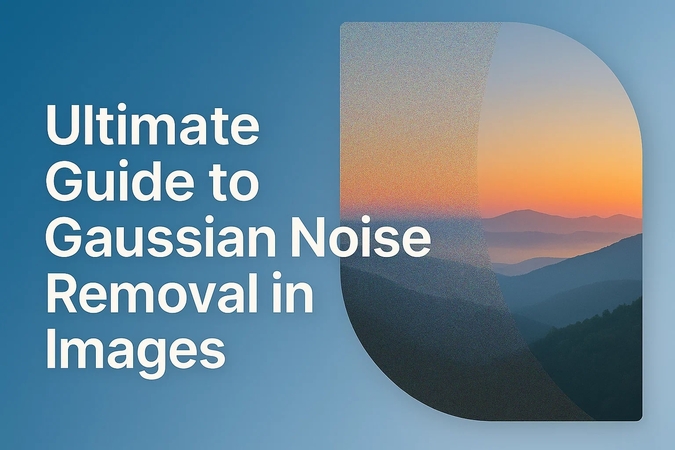
Part 1. Understanding Gaussian Noise and Its Impact on Image Quality
When noise levels in images are plotted, they form a bell-shaped curve around a mean. Most noise values are gathered around the mean and fewer at the corners. This statistical noise that follows a normal distribution is called Gaussian Noise. In images, it appears as random variations in brightness, visible as grains in smooth areas.
Sources of the Gaussian Noise
The following list features the factors that might cause users to apply the Image denoising techniques:
1. The thermal fluctuations or electronic interference cause sensor noise in digital cameras, resulting in noisy results.
2. Taking pictures in low light conditions increases the amplification of weak signals, also amplifying noise.
3. Transmission errors that occur during image data transfer can introduce unwanted noise into the image.
4. Analog-to-digital conversion using older imaging hardware can introduce Gaussian noise into an image due to inaccuracies during the signal sampling.
Effects on Image Quality of Gaussian Noise
1. Having Gaussian noise in images causes loss of detail in fine textures or low-contrast regions.
2. It can result in a photo with reduced contrast, making objects indistinguishable.
3. This noise makes it harder for computer vision systems to detect objects and separate different parts of an image.
Part 2. Gaussian Noise Removal Techniques in Image Processing
Removing Gaussian noise from images has many applications in image processing, which are elaborated in this brief table below:
| Category | Technique | Description | Pros | Cons |
|---|---|---|---|---|
| Spatial Domain Filters | Mean Filtering | Replaces each pixel’s value with the average of other pixels. | Fast and straightforward. | Blurs edges and is not ideal for preserving image details. |
| Median Filtering | Replaces each pixel’s value with the median of the other pixels. | Good at preserving edges. | Applicable for salt and pepper noise and less effective for pure Gaussian noise. | |
| Frequency Domain Filters | Gaussian Filtering | Applies a Gaussian function to smooth the image and reduce high-frequency noise. | Efficient and preserves low-frequency content. | May blur important high-frequency details, like edges and textures. |
| Wiener Filtering | An adaptive filter that minimizes the mean square error between the estimated and actual image. | Effective in restoring images with known noise characteristics. | It is complex and requires prior knowledge of noise and signal statistics. | |
| Advanced Techniques | Non-Local Means Denoising | Compares patches across the image and creates an average of the similar patches. | Excellent at preserving texture and fine details. | Slower than basic filters. |
| Wavelet Transform | Decomposes the image into different frequency bands and removes noise at each level using thresholding techniques. | A good balance between noise reduction and detail preservation. | Requires careful tuning of thresholds and wavelet parameters. |
Part 3. 4 Applications of Gaussian Noise Removal in Various Fields
Gaussian noise reduction can be a useful technique in many fields, some of which are discussed below:
1. Medical Imaging: In medical imaging, Gaussian noise can distort important anatomical details and make diagnosis more difficult. Removing this noise helps doctors see clearer images for better investigations.
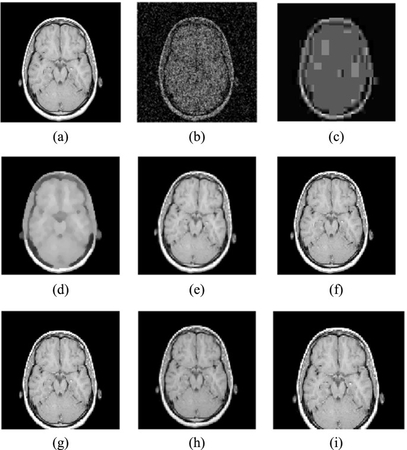
2. Astronomy and Space Imaging: Images captured by telescopes have Gaussian noise due to low light conditions and electronic interference. Denoising techniques help astronomers identify faint celestial objects that are hidden.

3. Surveillance and Security Systems: Surveillance cameras operate in low-light or challenging environments, where Gaussian noise can blur visual details. Gaussian noise suppression improves image quality to ease the process of identification.

4. Photography and Videography: Photographers and videographers often deal with Gaussian noise in low-light conditions. Removing noise from images and videos improves visual quality to ensure a professional result.

Part 4. Implementing Gaussian Noise Removal in Python
Tech geniuses can use coding language libraries to get rid of Gaussian noise from pictures. The following section is about implementing Gaussian noise reduction in Python alternative coding libraries:
1. Using OpenCV
Being a widely used library, OpenCV is optimized for performance, making it ideal for real-time applications or large datasets. This library is useful when working with complex image processing tasks that require smooth, noise-free images for high accuracy. This library supports a wide range of input formats and integrates with machine learning models to provide extensive documentation. The following image is an example of an OpenCV code that removes this noise from photos.
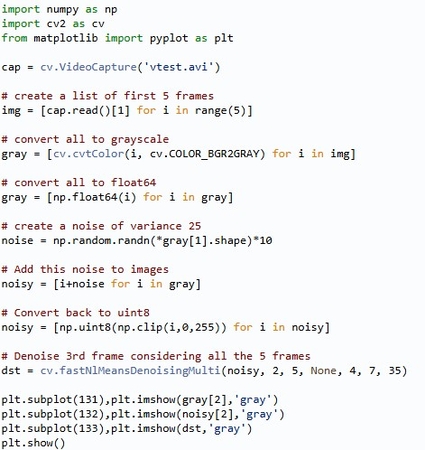
2. Using SciPy
SciPy is an excellent Gaussian noise suppression method for scientific and numerical computations, helping you effectively get rid of grains. Its filter application function is fast and provides high-quality Gaussian filtering. Despite the inability to work with real-time situations, SciPy is supportive in situations where precision and control over the noise removal process are important. You can look at the image below for an example of Gaussian noise coding using SciPy.
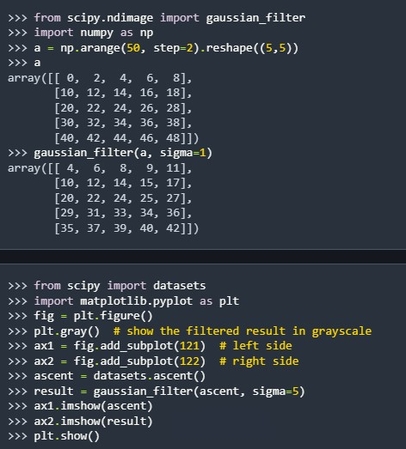
3. Using Pillow
Using this digital image noise removal coding library, you can execute many general image manipulation tasks. It simplifies image loading, processing, and saving, making it ideal for smaller projects or when working with simple image editing tools.
Designed with simplicity in mind, the filter function here is perfect for quick, hassle-free noise removal. To have an idea about the commands you need to enter to remove Gaussian noise using Pillow, refer to the image below:
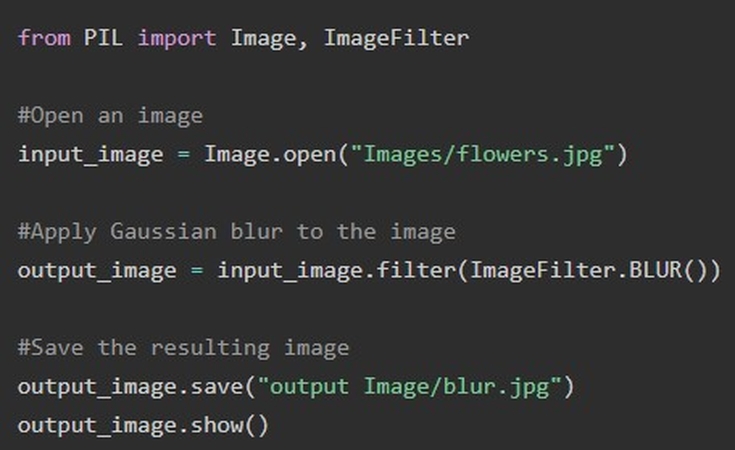
Part 5. Enhancing Image Quality with HitPaw FotorPea's Advanced Denoising Model
Despite harming the picture’s aesthetic, a noisy picture can blur out its details. To overcome this, you will need a digital image noise removal tool, like HitPaw FotorPea. Offering you a variety of AI enhancement models, this platform caters to each use case and shows effective results. If you are not sure which model to use, enable the Auto Select Model to let AI detect the use case and enable a relevant option.
Furthermore, users can enhance any image, from a family portrait to anime photos. This tool allows you to import a picture from your device or use a sample image to upgrade the quality. As a reliable tool for image enhancement, HitPaw FotorPea sharpens visual fidelity and keeps fine details intact.
Features of HitPaw FotorPea
1. Preview Results: To make sure that the results match your needs, this platform allows you to compare the image before and after enhancement.
2. Export Options: Using this tool, you can save enhanced images in the format and quality of your choice.
3. Batch Enhancement: This Gaussian noise elimination technique enhances your productivity by allowing a batch processing feature.
A Complete Tutorial on Removing Gaussian Noise from Images Using HitPaw FotorPea
Knowing how you can upgrade image quality is essential to maintain your social media aesthetic. The following guide will help you learn how to use HitPaw FotorPea to remove Gaussian noise:
Step 1. Access the Image Enhancer Using the Main InterfaceUpon downloading the tool on your desktop, select the “Enhance Photos Now” button to reach the next interface.

Step 2. Select and Import an Image to Enhance
Using the “+” icon in the middle of the next screen, select and import a picture with Gaussian noise.
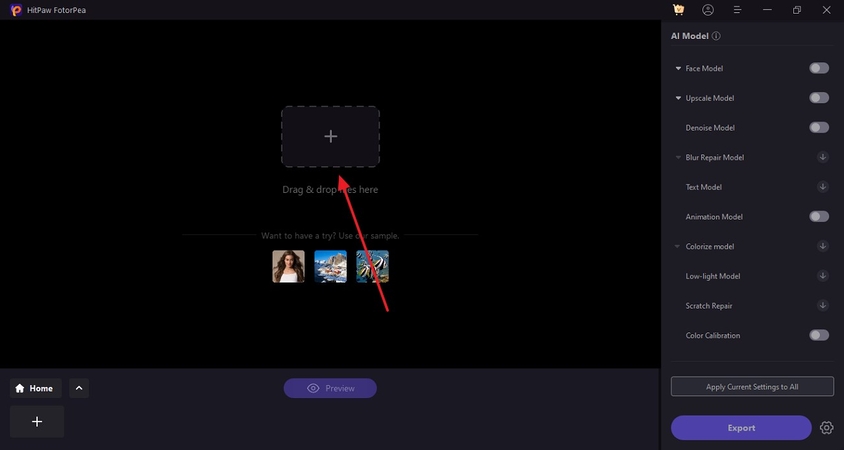
Step 3. Enable the Denoising Model and Preview the Generated Results
As the photo is imported, go to the right panel, enable the “Denoise Model,” choose an appropriate “Mode” for removing Gaussian Noise and select the “Preview” button to see the enhancement results.
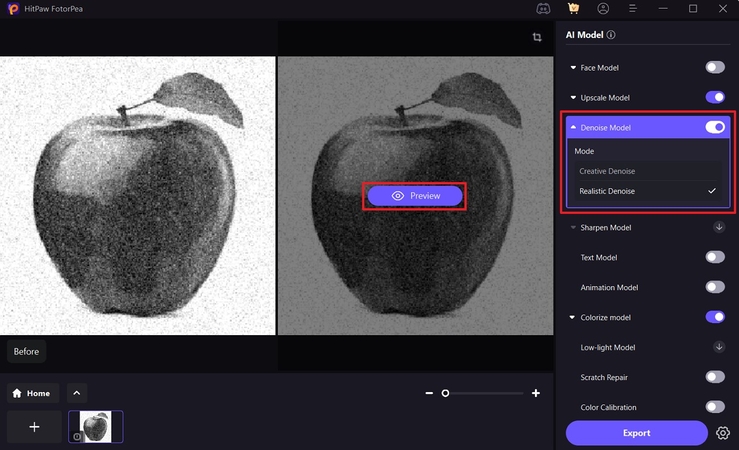
Step 4. Hit Export to Save the Enhanced Picture to Your Device
After upgrading the quality of your picture, go to the bottom right and select “Export.”
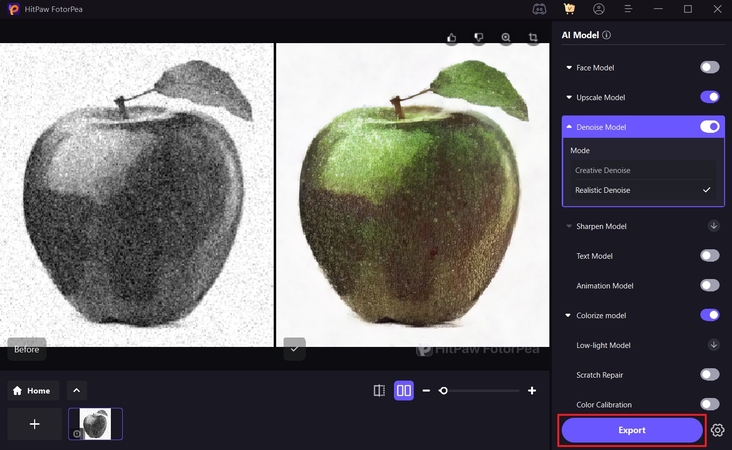
Conclusion
In essence, this article discussed the details of Gaussian noise removal from images. After learning the intricacies of Gaussian noise and its practical applications, we explored HitPaw FotorPea as a robust image enhancer. This platform offers you various upscale models to improve image quality and enhance your social media aesthetic.




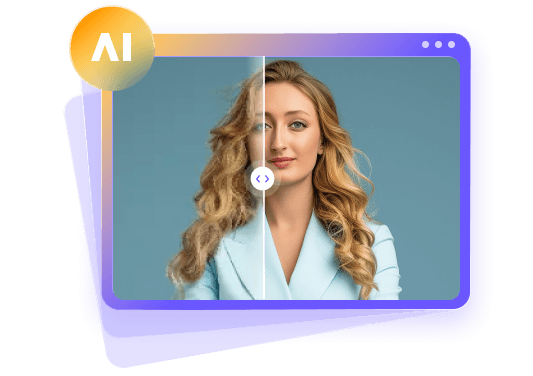




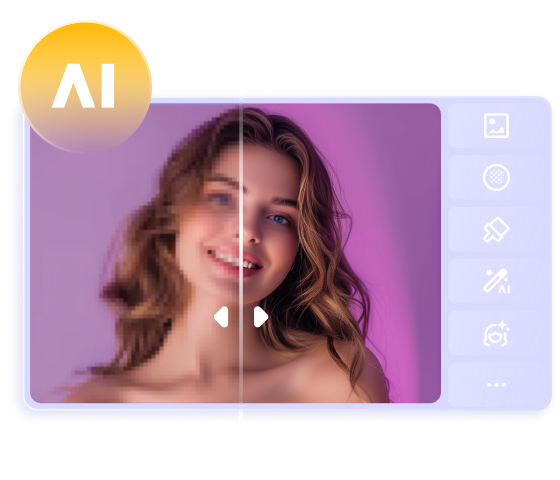
 HitPaw Edimakor
HitPaw Edimakor HitPaw VikPea (Video Enhancer)
HitPaw VikPea (Video Enhancer) HitPaw Univd (Video Converter)
HitPaw Univd (Video Converter) 

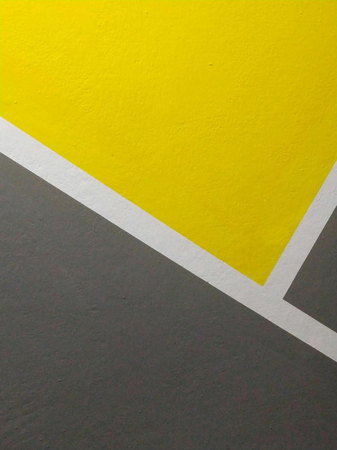

Share this article:
Select the product rating:
Daniel Walker
Editor-in-Chief
This post was written by Editor Daniel Walker whose passion lies in bridging the gap between cutting-edge technology and everyday creativity. The content he created inspires the audience to embrace digital tools confidently.
View all ArticlesLeave a Comment
Create your review for HitPaw articles